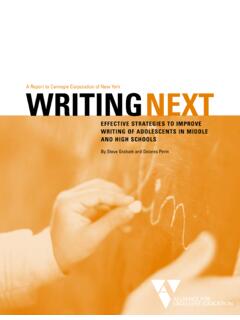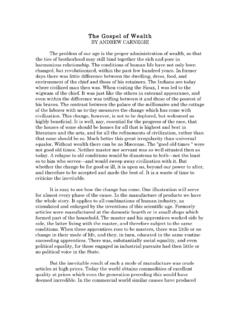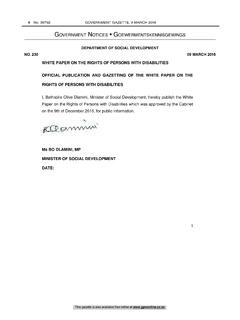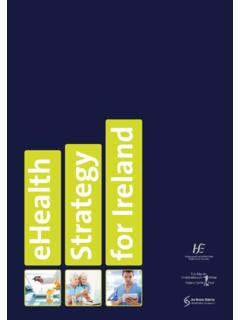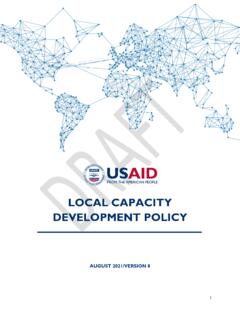Transcription of Embracing a New Normal: Toward a More Liberatory …
1 30 1pt lineNegative space 2 line widths = pts. step & repeatEmbracing a New Normal: Toward a More Liberatory Approach to Family EngagementA Report NewNormal | Twitter: @ CarnegieCorp | Facebook: @ CarnegieCorporationWritten byKaren L. MappEyal BergmanJune 2021230fi1pt lineNegative space 2 line widths = pts. step & repeatOur goal is to motivate a transparent, honest, and thoughtful interrogation of what stands in the way of authentic partnerships between families and schools and to show the way Toward a more Liberatory , solidarity-driven, and equity-focused family engagement practice that supports educational excellence for all children. Karen L. Mapp and Eyal Bergman, Authors of Embracing a New Normal On the Cover: As a supplement to Embracing a New Normal, the authors collaborated with five grantee partners of Carnegie Corporation of New York that are innovating and leading in the field of family school partnerships.
2 In January 2021, amid the COVID-19 pandemic and a renewed national reckoning on systemic racism, they spoke via Zoom with grantee staff, family, school, and commu-nity partners to reflect on, explore, and rethink family engagement practices. Pictured on the cover (clockwise from top left) and featured in this report: Nathaniel Royal, parent, New Orleans, LA; Jessica Picasso, kindergarten teacher, San Jose, CA; Monica Roberts, chief of student, family & community advancement, Boston public Schools; and Georgia Gross, curriculum specialist, Baton Rouge, LA. To learn more about the grantee partners and hear directly from family and school stakeholders, visit 3 The Education program at Carnegie Corporation of New York seeks to bring together families, commu-nities, students, educators, policymakers, and the public in support of an equitable and high-quality educa-tional system.
3 We fund programs that bridge the gap between home and school, because we believe that when families are empowered as true partners in their chil-dren s education, students thrive, schools are stronger, and the whole community benefits. We want families to have access to the information they need to support their children s learning and to be able to act as effective advocates for change. When schools shut down in March 2020 due to the pandemic, we finally broke the imagined boundary that existed between home and school. Parents suddenly had a front row seat to their children s learning, gaining new visibility into their education. Family engagement, the concept of schools partnering with families to help them support their children s learning and development, is not new, but the pandemic brought its importance front and center. Research shows that parent involvement at home has more than double the impact on student test scores than parents education level or socioeconomic status.
4 Family engagement is also a critical factor for equity in education, which demands our order to start a national conversation about effective family engagement practices and how they can become essential components of systems change, we commis-sioned Karen L. Mapp, a leading expert on family engagement at the Harvard Graduate School of Education, to write a paper on sustainable and equitable family engagement. The report underscores how, due to the pandemic, family engagement is finally being recognized as a core strategic component of any intentional effort to provide equitable and excellent educational opportunities for all children. However, even with this acknowledgment, federal, state, and local education entities and stakeholders struggle with how to create and sustain effective family engage-ment strategies and initiatives. This report challenges us to build effective and equitable family engagement practices throughout our educational system and provides recommendations for doing so to the field.
5 We hope this report serves as a call to action for all stakeholders in the education community to prioritize family engagement at all levels, specifically the creation of family-school partnerships built on a framework of trust and respect as an essential component of student and school success. Ambika KapurProgram Officer, EducationCarnegie Corporation of New YorkPREFACE4 Voices for EngagementNathaniel Royal, Parent, New Orleans, LA I trusted that the school was giving my daughter proper feedback, telling us if something was wrong. But that wasn t always the case. Now I m more focused on her work and her grades. We communicate with her teacher more. Now that she s remote, at times I m in the room listening to the teacher, and I think, That doesn t make sense. Or I push my daughter to answer a question if I think she s being quiet. This experience has got me more focused on what the school system is actually doing.
6 5 CONTENTSI ntroductionEmbracing a New NormalNaming the ChallengeThe Way ForwardRecommendations for the FieldConclusionEndnotes678112123246 Over the past 50 years, there has been a contin-uous push to recognize family engagement as a fundamental component of student success and school improvement. Scores of research studies, reports, and articles have linked family engagement to bene-ficial outcomes for students, educators, and Throughout much of this time, however, change efforts were met with denial, resistance, or outright rejection by various education In 2018, Carnegie Corporation of New York commis-sioned a challenge paper to serve as a call to action, titled Joining Together to Create a Bold Vision for Next-Generation Family Engagement: Engaging Families to Transform This paper, prepared by the Global Family Research Project, summarized the research on family engagement, outlined a vision for the next generation of family engagement, and identi-fied high-leverage areas to consider in building family engagement strategies.
7 Since then, some districts have begun to embrace family engagement as a strategic component of teaching and learning, investing in family engagement departments and cabinet-level staff to guide the work. Overall, however, change in this area has remained dual pandemics of COVID-19 and systemic racism are forcing a recalibration of family-school partnerships. Finally, the engagement of families in their children s education particularly nondominant families, defined as those impacted by systemic oppression, such as marginalization based on race, class, language, or immigration status 5 is being taken seriously. The shift to remote learning has forced educators to prior-itize collaborations with families instead of thinking of them as nice to do when we have time. And educa-tors are noticing, many for the first time, that families know more, see more, and can do more than previously acknowledged.
8 Districts and schools are examining how power and privilege are determined and distributed in their communities and which families have a voice and a seat at the table. The two crises that came to a head in 2020 are fundamentally reshaping the relationships between home and school and galvanizing long-overdue conversations and changes in practice and policy about family this report, we are issuing a second call to action: for the PreK 12 sector to walk through the door opened by COVID-19 and the antiracist movement and address the often-ignored and unspoken dynamics that prevent the cultivation of effective partnerships between families and educators. We call on the sector to seize this oppor-tunity to move Toward a family engagement practice that is Liberatory , solidarity-driven, and equity-focused. In the following sections, we describe what this new normal would look like, as well as the underlying challenges that have inhibited effective home-school partnerships in America.
9 We then outline a path forward for the PreK 12 sector and offer recommendations for systems leaders who may be seeking to use the historic infusion of nearly $200 billion in federal stimulus funds to advance a new vision for their family and community engagement work. INTRODUCTION7We have a choice about this crisis. As educators, we can make our new normal better than the old, engaging parents as the partners they are. Or we can wait for parents to lose whatever faith in us remains. They cannot unsee what they have witnessed so vividly in their own living rooms. Sonja Brookins Santelises, CEO, Baltimore City public SchoolsIn a December 2020 EdWeek op-ed, Baltimore City public Schools CEO Sonja Brookins Santelises called for educators to take advantage of the disruption caused by COVID-19 to dismantle longstanding educa-tional inequities, with parents as We echo this call and propose three fundamental principles for family engagement that is Liberatory (free of dominance), solidarity-driven (in union and fellowship), and equity-focused (fair and just).
10 First, schools must reject deficit-based views of families. Most family engagement initiatives, particu-larly those aimed at nondominant families, are designed with a deficit-based lens. Even well-intentioned efforts often define families by what they don t have or don t do. We see any attempt to solve other people s problems for them as reinforcing principles of oppression, priv-ilege, and individualism. Dominant and hierarchical programs and activities keep families at arm s length and deny them access to power and do more to discourage engagement than to encourage meaningful new normal must be built on antiracist and social justice principles. Families from all backgrounds must be seen and celebrated as the geniuses that they are, in the words of Shantae Toole, cofounder and codirector of First Teacher in They must be embraced by educators as equal partners and recognized as experts on their children and Second, the new normal requires a codesign model of engagement.

